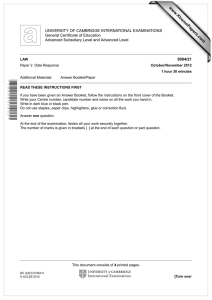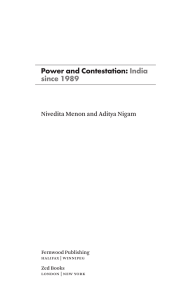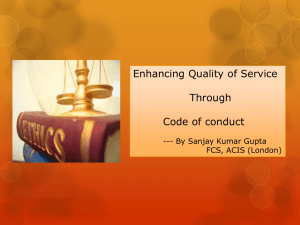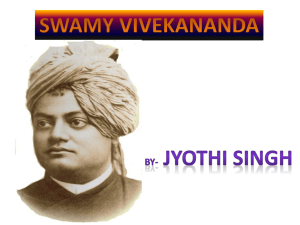Nivedita : The Queen of the Indian Freedom Movement
advertisement
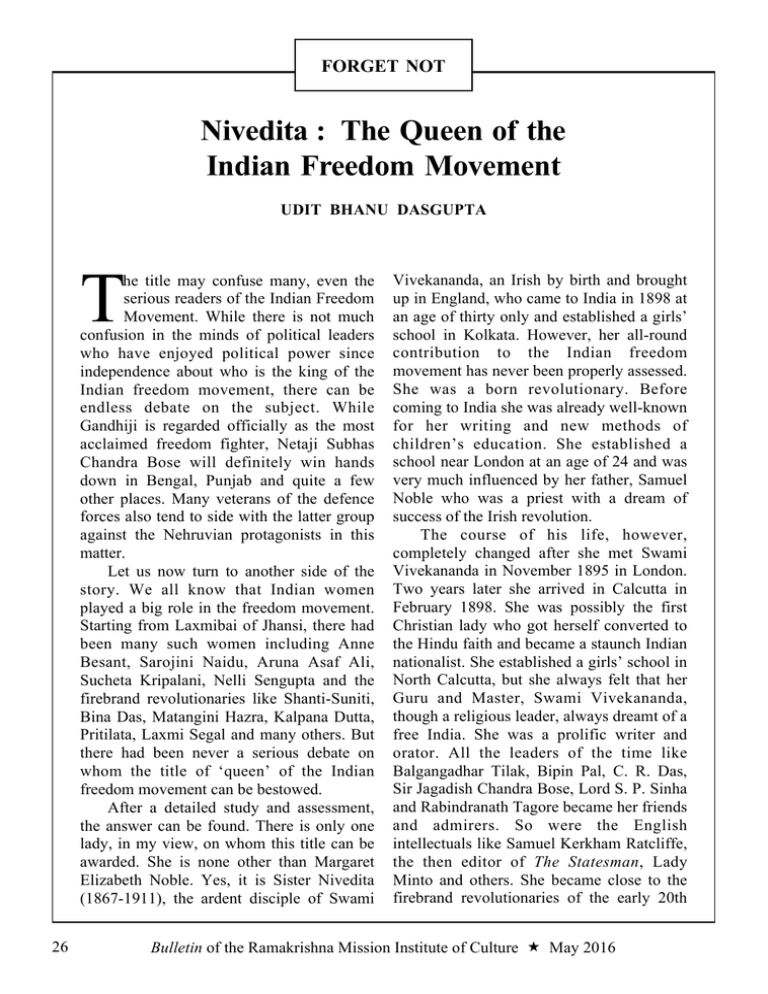
UDIT BHANU DASGUPTA FORGET NOT Nivedita : The Queen of the Indian Freedom Movement UDIT BHANU DASGUPTA T he title may confuse many, even the serious readers of the Indian Freedom Movement. While there is not much confusion in the minds of political leaders who have enjoyed political power since independence about who is the king of the Indian freedom movement, there can be endless debate on the subject. While Gandhiji is regarded officially as the most acclaimed freedom fighter, Netaji Subhas Chandra Bose will definitely win hands down in Bengal, Punjab and quite a few other places. Many veterans of the defence forces also tend to side with the latter group against the Nehruvian protagonists in this matter. Let us now turn to another side of the story. We all know that Indian women played a big role in the freedom movement. Starting from Laxmibai of Jhansi, there had been many such women including Anne Besant, Sarojini Naidu, Aruna Asaf Ali, Sucheta Kripalani, Nelli Sengupta and the firebrand revolutionaries like Shanti-Suniti, Bina Das, Matangini Hazra, Kalpana Dutta, Pritilata, Laxmi Segal and many others. But there had been never a serious debate on whom the title of ‘queen’ of the Indian freedom movement can be bestowed. After a detailed study and assessment, the answer can be found. There is only one lady, in my view, on whom this title can be awarded. She is none other than Margaret Elizabeth Noble. Yes, it is Sister Nivedita (1867-1911), the ardent disciple of Swami 26 Vivekananda, an Irish by birth and brought up in England, who came to India in 1898 at an age of thirty only and established a girls’ school in Kolkata. However, her all-round contribution to the Indian freedom movement has never been properly assessed. She was a born revolutionary. Before coming to India she was already well-known for her writing and new methods of children’s education. She established a school near London at an age of 24 and was very much influenced by her father, Samuel Noble who was a priest with a dream of success of the Irish revolution. The course of his life, however, completely changed after she met Swami Vivekananda in November 1895 in London. Two years later she arrived in Calcutta in February 1898. She was possibly the first Christian lady who got herself converted to the Hindu faith and became a staunch Indian nationalist. She established a girls’ school in North Calcutta, but she always felt that her Guru and Master, Swami Vivekananda, though a religious leader, always dreamt of a free India. She was a prolific writer and orator. All the leaders of the time like Balgangadhar Tilak, Bipin Pal, C. R. Das, Sir Jagadish Chandra Bose, Lord S. P. Sinha and Rabindranath Tagore became her friends and admirers. So were the English intellectuals like Samuel Kerkham Ratcliffe, the then editor of The Statesman, Lady Minto and others. She became close to the firebrand revolutionaries of the early 20th Bulletin of the Ramakrishna Mission Institute of Culture May 2016 NIVEDITA : THE QUEEN OF THE INDIAN FREEDOM MOVEMENT century, many of whom got their inspiration from Vivekananda’s writings which Nivedita spread across the country. After Vivekananda’s death on 4 July 1902, Nivedita’s association with the freedom fighters and Indian political leaders increased. She travelled all over India and gave lectures in which she called for total upliftment of India and spread the message of Swamiji’s ‘Man-making’ ideal. Pioneer revolutionary, Aurobindo Ghosh (later Sri Aurobindo of Pondicherry) formed a committee to unite various splinter groups of firebrand revolutionaries operating in different parts of India. Nivedita along with C. R. Das, Suren Tagore and others were members of this committee. She once remarked ‘In Ireland, we have a saying that England yields nothing without bombs, every reform has to be wrested from government’ (Agni Yug by Sailesh De, Purna Prakashan). In 1905 when Lord Curzon divided Bengal, Nivedita criticized the move saying ‘Shame on my country of origin. But we shall continue to struggle’. Thus Nivedita got actively involved in politics by preaching an idea of dynamic religion. She used to say: ‘The ideal struggle would come through non-violence as preached by our sages, but are we capable of it?. . . The man who does not strike because he is weak commits a sin. The man who does not strike because he is afraid is a coward’. Nivedita attended Benaras Congress in December 1905, where Balgangadhar Tilak was the President. She never came in front but worked from behind as a correspondent of The Statesman. The Congress session became a ‘Nivedita show’. She tried her best to forge an understanding between the radicals and the moderates. Soon afterwards she came under police surveillance. Next, the ‘Alipore Bomb Case’ (1909) came up involving Aurobindo Ghosh and others. She arranged the escape of Bhupendra Nath Dutta (brother of Vivekananda) after his conviction for revolutionary activities. The British government accused her of treacherous action. Nivedita felt that various fragmented groups of firebrand revolutionaries are to be brought under one umbrella. She also travelled to various corners of India and gave inspiring speeches to young people to rouse them to action. She realized from the teaching of Swami Vivekananda that unless a sense of nationalism is developed, India can never get her freedom. However, while working to kindle the spirit of nationalism, she did not neglect the school she founded. Though she had to dissociate herself officially from the Ramakrishna Mission after the death of Vivekananda, she maintained her deep personal relations with the monks of the Math and the Mission, and Holy Mother Sarada Devi. Nivedita not only advised the national leaders and patriots but she always tried to inspire a generation of young people in her own ways. Her methodology was quite different. Once she spread a huge map of undivided India (6 ft x 4 ft) in front of a large number of young people and said passionately: ‘Look at your mother, she is chained. Now you decide what you should do’. Nivedita tried her best to ignite the spirit of the revolutionaries in ways which were common in Ireland and Russia. During her visit to Ireland, she had asked her brother, Richard, to secretly send her the Irish revolutionary periodicals. She, in turn, used to distribute them among the Bengal revolutionaries. After the arrest of Lala Lajpat Rai and Sardar Ajit Singh, many protest meetings were held in and around Calcutta and Nivedita was always the main speaker. She used to quote passages from the Gità, where Krishna inspired reluctant Arjuna to start the battle, to encourage the youths to wage their Bulletin of the Ramakrishna Mission Institute of Culture May 2016 27 UDIT BHANU DASGUPTA battle against the British empire. When a team of revolutionaries under the leadership of Ullaskar Dutta were at the finishing stage of developing bombs desperately needed a sophisticated laboratory, they approached Nivedita. Nivedita, who was a close friend and mentor of Jagadish Chandra Bose, the great scientist, requested the latter to talk to his friend, another leading chemist P. C. Ghosh, to allow Ullaskar and his team to use the chemistry laboratory of the Presidency College. The approval was obtained and the young men started their experiments in the late evening. By morning there was no trace of any objectionable chemicals. The rest is history—the famous Alipore Bomb Case. Ullaskar and many others were subsequently sentenced to long imprisonment in the Andamans. But the knowhow of bombmaking was developed. Nivedita always wanted the revolutionaries to have access to bombs in line with the Irish revolutionaries. All the leading revolutionaries of the first decade of the 20th century used to visit Nivedita regularly for inspiration and guidance. Nivedita was well aware of the need of the Hindu-Muslim unity. Swamiji had earlier said that what India needed was Vedantic brain and Islamic body. So Nivedita also thought in the same line. She addressed quite a few Muslim gatherings. In one such meeting she remarked that the Muslims should be a great force of national cohesion. The duty of the Indian Muslims today was not to relate themselves with distant Arabia. Their duty was to relate themselves with India which was their home by blood—the heritage to which they had been born. It was for this reason that a leading advocate of Lucknow once remarked ‘There were very few Indians, who were more devoted to the idea of Hindu-Muslim unity than her.’ The famous South Indian poet and revolutionary, 28 Subramanium Bharati was so inspired after meeting her that he dedicated his first book to Nivedita. The great revolutionary Hem Chandra Ghosh (who was the founder of Bengal Volunteers) met her a number of times and organized her lecture tours. In her lectures Nivedita kept spreading the man-making gospel of Swami Vivekananda across India. Swamiji told Hem Chandra that man-making was the mission of his life. Swamiji could neither get directly involved in politics nor had much truck with the revolutionaries although his constant dream was independent India. This dream always electrified Nivedita and she had taken up the cause. Swamiji made her a ‘Brahmacharini’, never a ‘Sannyasini’. One of the reasons behind this action could be that he had seen the fire in his disciple. He realized perhaps that after his death, Nivedita cannot remain content within the confines of the girls’ school. It is worthwhile to mention here what Swami Vivekananda expected from Sister Nivedita. This expectation was expressed in his ‘A Benediction’ written to Nivedita. Swamiji wrote: Be thou to India’s future son The mistress, servant, friend in one. So, Nivedita was absolutely clear about what her Guru wanted from her regarding India, and how deeply he felt about the freedom of India. Nivedita was so inspired by Vivekananda’s love for India, she once told the legendary revolutionary Hem Chandra Ghosh that ‘India was Swamiji’s greatest passion. The thought of India was virtually an obsession with him. India throbbed in his breast, India beat in his pulse, India was his day-dream, India was his nightmare. He was the embodiment of India in flesh and blood. He was India, he was Bharat, the very symbol of her Bulletin of the Ramakrishna Mission Institute of Culture May 2016 NIVEDITA : THE QUEEN OF THE INDIAN FREEDOM MOVEMENT spirituality, her wisdom, her power and her destiny.’ Nivedita made two trips to Europe and USA after Vivekananda’s death, in 1907 and 1910. Wherever she went she highlighted the problems of India. She helped scientist Jagadish Chandra Bose draft his paper and supported him when a team of Western scientists ganged up to challenge his discovery. She wrote several books, ‘Kali the Mother’, ‘Cradle Tales of Hinduism’, ‘Web of Indian Life’ and regularly wrote articles in newspapers and journals on Indian freedom struggle and the memorable volume on Swami Vivekananda titled ‘The Master as I Saw Him’. Veteran journalist Ramananda Chatterjee wrote about Nivedita: She was a pronounced nationalist with radical political ideas. She could never forgive partisanship or faction fights in Indian politics. She believed in the great need of efficacy of presenting a united front; the promotion of the cause of the nation was with her as much a mission and a passion as was women’s education. She died at an early age of 44 at Darjeeling after fourteen years of total stay in India. The legendary pioneer revolutionary and founder of the INA in Japan, Rashbehari Ghosh, wrote after her death: ‘If the dry bones India was beginning to stir, it was because Nivedita breathed life into them. If we are conscious of a budding national life, it is because of her. If our young men were inspired with a burning passion of a purer, nobler life, the credit should go to the lady.’ Netaji Subhas Bose wrote: ‘I loved India after reading Vivekananda and I could know Vivekananda after reading Nivedita.’ Rabindranath Tagore called her ‘Lokmata’—mother of the people. So there cannot be any doubt about the immense contribution Nivedita made to the Indian freedom struggle. Her contributions seem outstanding when compared with any other women of the pre-independence era. Unfortunately no comparative study on the role and contributions of the women freedom fighters in India has been undertaken so far. The point on which Nivedita scored much above all others was that she inspired a generation of top leaders of the country and legendary revolutionaries. The well-known parliamentarian, Samar Guha, who was a revolutionary during his youth, once wrote in an article that ‘Vivekananda made the pedestal for revolution and Nivedita ignited the fire’. Swami Devendrananda in his book writes that if ever an independent and unbiased history of Indian independence movement is written, then her name will feature at the top. I would like to add that her name will be right on top of all women freedom fighters. Therefore there is no problem in giving the crown of the ‘queen’ of the Indian freedom movement to this much-forgotten ‘Sister’—Nivedita. BIBLIOGRAPHY 1 Swami Purnatmananda, Swami Vivekananda, Bharater Swadhinata Sangram. 2 Nalini Ranjan Chattopadhyay, Samaj O Sahitye Vivekananda O Nivedita. 3 Amiya Mazumdar (edited), Nivedita Commemoration Volume. 4 Shankari Prasad Basu, Nivedita Lokmata (Vol. I). 5 Lizelle Raymond, The Dedicated. 6 Swami Vivekananda, The Complete Works, Vol. VI. * Sri Udit Bhanu Dasgupta is the Chief Executive of a Kolkata-based firm and a freelancer. Bulletin of the Ramakrishna Mission Institute of Culture May 2016 29

